#Ion Propulsion
Explore tagged Tumblr posts
Text
EP. 13: FIVE REALISTIC WAYS TO REACH THE STARS.
In the future, humans will explore the stars. This may happen in a few decades or centuries, but it is inevitable. The long time period is due to the fact that stars are incredibly distant, beyond what we can imagine. Our current technology is not advanced enough to travel through interstellar space. However, as we advance in our understanding of physics and technology, it is likely that we will…
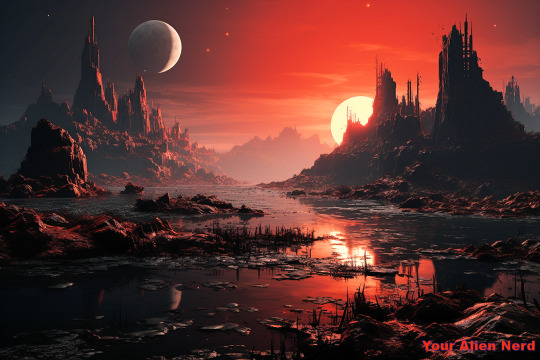
View On WordPress
#anti-matter propulsion#generation ship#interstellar travel#ion propulsion#Proxima b#Proxima Centauri#Proxima Centauri b#solar sail#warp bubble#warp drive#wormoholes
2 notes
·
View notes
Text
Quantum Footprints in the Cosmos: The Calculus of Space Exploration
Quantum Footprints in the Cosmos: The Calculus of Space Exploration Quantum mechanics governs the behaviour of particles at microscopic scales. But space, with its vacuum, high radiation, and zero-gravity conditions, reveals phenomena that only quantum physics can explain. From precision in navigation systems to understanding black holes, quantum mechanics enables us to interpret and engineer…

View On WordPress
#Atomic Clocks# Science Blog#Calculus in Physics#Ion Propulsion#Quantum Communication#Quantum Entanglement#Quantum Mechanics#Quantum Tunnelling#Satellite Navigation#Schrödinger Equation#Space Exploration
0 notes
Link
Embark on a cosmic voyage with today's episode of Astronomy Daily - The Podcast, where your host, Anna, steers us through the latest developments in the universe. We're launching with NASA's new launch date for Boeing's Starliner crew flight test, aiming for a June 1 lift-off. Then, we'll glide over to NASA's Psyche mission as it sails towards a metal-rich asteroid using ion propulsion, passing its six-month health check with flying colors.We'll also dive into a paradigm-shifting study on the sun's magnetic fields, potentially redefining our understanding of solar phenomena. And don't miss our conversation with Dr. Tom Marshburn on the medical marvels being uncovered in the microgravity of space, promising a healthier future for us on Earth.Finally, we'll touch down at the Museum of Science and Industry in Chicago, where SpaceX's Dragon capsule has found a new home, inspiring the next generation of space explorers. (00:00) This week's Astronomy Daily features some fascinating updates in space and astronomy (00:51) NASA sets June 1 as earliest possible opportunity for Boeing's Starliner crew test (05:36) New research suggests the sun's magnetic fields originate from much shallower processes (08:29) Research into how space affects astronauts is driving medical breakthroughs on Earth For an astronomical experience, visit our website at astronomydaily.io for the latest news, sign up for our free newsletter, and check out exclusive sponsor deals. Connect with us on X (@AstroDailyPod) for engaging discussions with fellow space aficionados.This is Anna, reminding you to keep your gaze fixed on the heavens. Until our next stellar episode, let the cosmos ignite your curiosity and wonder. Clear skies and cosmic discoveries to all! Become a supporter of this podcast: https://www.spreaker.com/podcast/astronomy-daily-the-podcast--5648921/support. www.astronomydaily.io www.bitesz.com Sponsor www.bitesz.com/nordpass
#asteroid#boeing#crew#fields#flight#ion#magnetic#medicine#metal-rich#microgravity#mission#nasa#propulsion#psyche#research#solar#space#starliner#technology#test
1 note
·
View note
Text
The ion engine of Deep Space 1, tested in the vacuum chamber of NASA's Jet Propulsion Laboratory
71 notes
·
View notes
Text
CAN WE ESCAPE THE MILKY WAY??
Blog#480
Saturday, February 15th, 2025.
Welcome back,
Getting out of the galaxy might take an antimatter engine. Future explorers departing the Milky Way will have to boost their spaceship to 0.2 per cent of the speed of light, according to a study of fast-moving stars in our galaxy.
Tilmann Piffl at the Leibniz Institute for Astrophysics in Potsdam, Germany, and his colleagues used the latest data from the Radial Velocity Experiment (RAVE) survey.

The survey uses the Anglo-Australian Observatory‘s 1.2-metre Schmidt telescope in Siding Spring, New South Wales, Australia, to measure the distances to stars and the speeds at which they are moving away or towards us, among other properties.
The latest survey studied about 426,000 stars.
From this survey and a previously published star catalogue, the team selected 90 high-velocity stars whose speeds and positions had been determined most precisely. Some of them are moving at speeds of more than 300 kilometres per second, about one-thousandth of the speed of light.

The team then studied various models of Milky Way-sized spiral galaxies to determine which one best fit the observed stars and their velocities. The most suitable simulated galaxies had masses of about 1.6 trillion suns.
“People used to say it was twice that,” says team member and astronomer Joss Bland-Hawthorn at the University of Sydney in Australia. “It’s not as massive as we thought.”
With the likely mass of the galaxy in hand, the team calculated the escape velocity for objects in the vicinity of our solar system.

To escape the gravitational clutches of our galaxy, a spaceship would need to zoom out of our solar system and hit 537 kilometres per second. For context, a rocket needs to roar off at just 11.2 kilometres per second to escape Earth’s gravity.
Conventional rocket engines would never make it. The chemical rockets that power most spacecraft today would require too much fuel, and even high-tech ion engines – which are efficient enough for long journeys around the solar system – max out at about 15 kilometres per second.

But Bland-Hawthorn speculates that a propulsion system powered by the energy released by combining matter with antimatter could do the trick. The challenge, of course, would be find ways to create and confine large amounts of antimatter. “I know it’s a crazy idea, but if you had lots of matter and lots of antimatter, you could power a spaceship out of the galaxy,” he says.
Originally published on https://www.newscientist.com
COMING UP!!
(Wednesday, February 19th, 2025)
"WHAT IS QUANTUM ENERGY??"
#astronomy#outer space#alternate universe#astrophysics#universe#spacecraft#white universe#space#parallel universe#astrophotography
76 notes
·
View notes
Note
Bainus: I just realized there is in fact up to three technologies in Izuku's ship that could be partially reverse engineered:
Star Wars ships almost universally use ion engines for sublight propulsion (the TIE in the TIE series refers to the Twin Ion Engines and the fact Raith Sienar managed to not only miniaturize the technology to the point he could put two high-performance ones on such a small platform, but also that they have zero moving parts and require minimal maintenance). Considering the technology already exists in real life, taking a look could improve the ones existing on MHA Earth... And drive a few engineers spare by how it interacts with the ship's artificial gravity.
Also, the artificial gravity, shown to exist in the final battle. Then again, SW artificial gravity had literally thousands of years to be perfected, this could have the same effect of living with Cthulhu for a year.
Depending on the model of power droids the ship has, nuclear fusion (some instead burn tibanna for an even higher output). Though this too could drive people spare with the fact they miniaturized nuclear fusion reactors to the point one powerful enough to supply a small city with electricity can be put in a human-sized droid, even assuming they avoided the RELIGIOUS Gonk droids (yes, some Gonks actually formed a cult).
In short, better keep people away from the ship, as even the technologies that could be reverse engineered are so advanced they would drive a few engineers insane trying (and there's a small chance the power droid, if it's a Gonk, will start waking people early on Sunday to collect donations).
Yeah he has plenty of reason to keep that hidden
25 notes
·
View notes
Text
Star Trek TOS ships. Part 2
Continuation of this other post. I list here the TOS alien vessels, as well as ships from the Animated Series. Ships from the movies are here.
Romulan ship

Introduced in Balance of Terror, it appears in The Deadly Years as well. The Romulan ships from The Enterprise Incident, however, are of Klingon design (see below), though the remaster replaced one of these with the properly Romulan ship. They're equipped with cloaking devices and plasma cannons. Although this design is popularly known as a Bird-of-Prey, this name was never used in TOS for the Romulan ships. The early outline of The Search for Spock, where the villains were still Romulans, refers to their ship as a Bird-of-Prey, but it wouldn't be until "Voyager" that this design was named on-screen.
Klingon ship
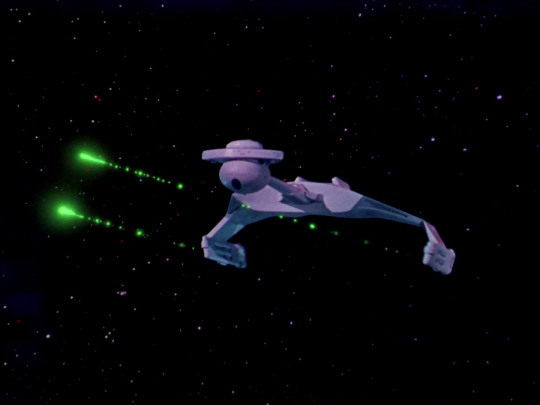
It makes its debut in Elaan of Troyius, and reappears in Day of the Dove. The Romulans seem to have been using them as well (The Enterprise Incident). Earlier versions of this script specified that this was due to an alliance between the Klingons and Romulans. The remaster introduced Klingon ships in episodes where none was seen originally: Errand of Mercy, A Private Little War and Friday's Child. This model is popularly known as a D7, but this name wasn't canonized until "Deep Space Nine".
Fesarius

The gigantic First Federation vessel, commanded by Balok in The Corbomite Maneuver. It could dispatch smaller pilot ships, as well as tamper with the Enterprise systems.
Tholian ship

Appears in The Tholian Web. Commanded by Loskene, this ship along a second one start weaving an immobilizing web around the Enterprise.
Eymorg ship


Piloted by Kara in Spock's Brain, this vessel used an ion propulsion system. It looks very different in the remaster.
Orion intruder
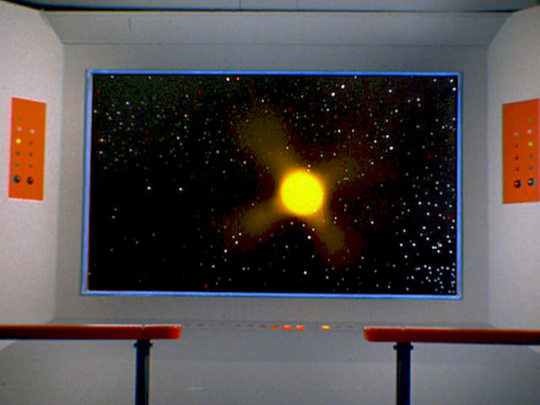

The ship that follows the Enterprise in Journey to Babel. It also looks quite different in the remaster.
Gorn ship
Only seen in the remaster of Arena, and barely.
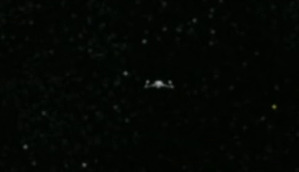
Medusan ship
Again, only visible in the remaster of Is There In Truth No Beauty?. Ambassador Kollos' ship.
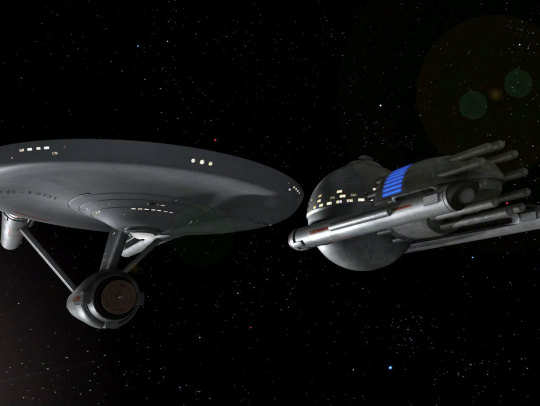
SHIPS FROM THE ANIMATED SERIES
Bonaventure 10281 NCC

According to Scotty, this was the first ship ever to have warp drive (something that later series obviously retconned). It must have been at least 100 years old, considering the Horizon and Archon had already visited distant planets by that time. It was lost inside the Delta Triangle and thrown into a parallel universe, as seen in The Time Trap. Looks just like a fat Enterprise, if you ask me...
SS Huron NCC-F1913

A freighter commanded by Captain O'Shea, attacked and raided in The Pirates of Orion.
Ariel
A ship commanded by Lt. Commander Markel, and found in orbit around Lactra Seven, in The Eye of the Beholder. Never seen on-screen.
Robot grain ships NCC-61465 and NCC-G1465


Two automated cargo ships that the Enterprise escorted to Sherman's Planet in More Tribbles, More Troubles. They were attacked by Koloth. This design was the inspiration for the remastered Antares and Woden in TOS.
Several Enterprise shuttlecrafts
The animated format eliminated budget problems when it came to showing more ships, so the Enterprise was given a ton of new shuttlecrafts. Among these, there are the ones seen in Mudd's Passion: NCC-1701/4, 9 and 12. Four and twelve seem to be a new model. Also notice the new tubular shuttle in the first image.
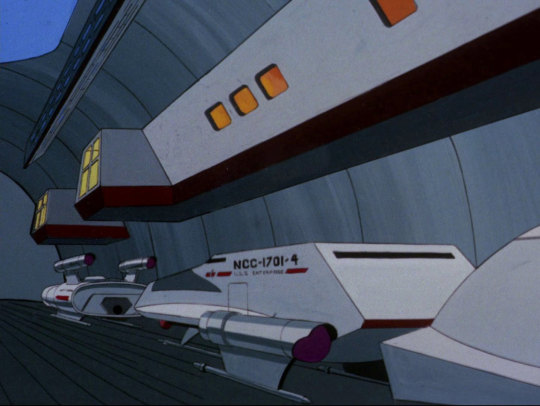


Strangely enough, the shuttle Copernicus from The Slaver Weapon is also numbered NCC-1701/12, yet it's not the same as the previous one.
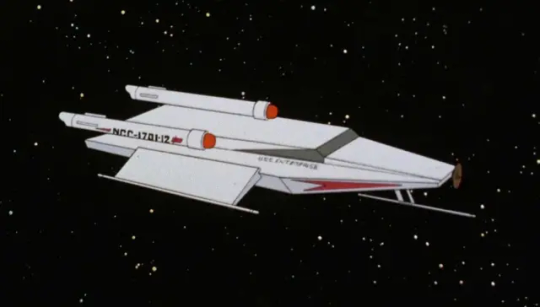
The aquashuttle from The Ambergris Element can sail on water and under it, as well as flying. The registry appears to be NCC-1701/A5 (the "A" probably stands for "aqua")
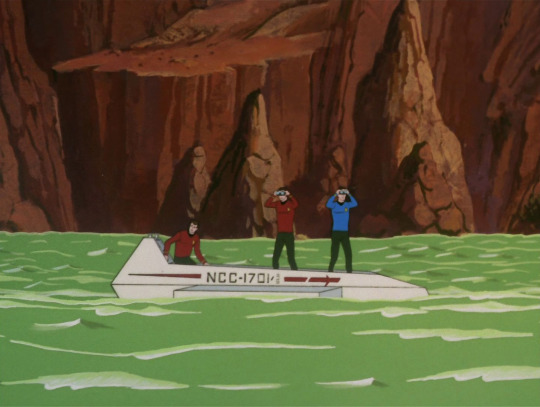
In the same episode, there's also a scouter-gig sent to rescue the crew, after the aquashuttle is destroyed. Its number appears to be NCC-1701/R6 (the "R" for "rescue"?)

Winston's trading vessel

The ship, apparently piloted by Winston Carter, that sends a distress call in The Survivor.
Cyrano Jones' scout ship
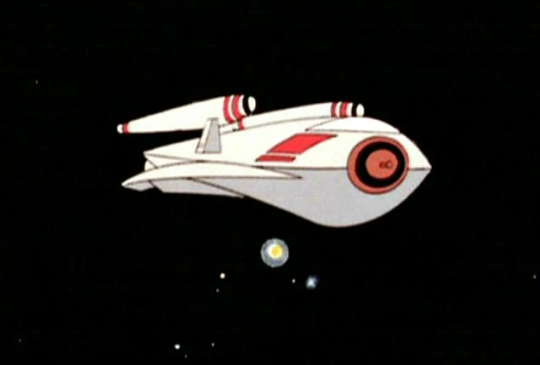
The ship that Cyrano used to escape from the Klingons, in More Tribbles, More Troubles.
Klothos

A Klingon battle cruiser commanded by Kor, that becomes trapped in a parallel universe along the Enterprise, in The Time Trap.
Dramian patrol ship

The ship that Demos (a Dramian alien) uses to pursue the Enterprise, in Albatross.
Traitor's Claw

A Kzinti police vessel from The Slaver Weapon, used to imprison the Enterprise crew.
Orion vessel

The ship that attacks the SS Huron in The Pirates of Orion. Quite different from the one that appears in Journey to Babel.
Phylosian ships

Strange plant-like ships intended to impose peace by the Phylosians, in The Infinite Vulcan.
Pod ship

An insectoid massive ship, destroyed 300 million years ago by an evil entity. Appears in Beyond the Farthest Star.
Antimatter universe ship

Piloted by Karla Five at impossibly high speeds, in The Counter Clock Incident. Originally from an antimatter universe, Karla Five was trying to escape the positive universe by driving this vessel into a supernova.
20 notes
·
View notes
Text

NASA has just confirmed something groundbreaking—Voyager 1 and 2 are coming home. After nearly five decades in interstellar space, both spacecraft will begin their return journey using a classified propulsion system secretly integrated into their design.
The plan was hidden from the public and Congress to prevent funding cuts. Ever since Apollo ended, Congress had been scaling back deep-space programs, so NASA kept this as a contingency.


Unlike their outward journey, which used gravity assists to escape the solar system, their return will rely on a gravitational recapture trajectory.
Jupiter and Saturn are perfectly aligned to provide back-to-back slingshots, boosting their speed to 78 km/s, nearly double their original velocity. Combined with high-efficiency ion thrusters, this will allow a rapid approach back toward Earth.


A key factor is the RTG nuclear battery reserve, a secret feature installed at launch. While the public specs listed only 470 watts of power, engineers had quietly included an additional 940-watt thermal energy reserve, intended for a controlled return if needed.
These RTGs will now activate the return thrusters, guiding both probes back into Earth’s gravitational influence.


NASA estimates reentry on 6/31/2037, over the Southern Hemisphere. The recovery plan ensures a controlled descent, preventing any risk of uncontrolled reentry.
Scientists are eager to analyze the spacecraft, which have endured nearly 50 years of deep-space exposure, providing rare data on long-term spaceflight durability.
For decades, Voyager was seen as a one-way mission. But this proves otherwise. The return of Voyager 1 and 2 will mark a historic moment—the first retrieval of an interstellar spacecraft and proof that no mission is truly final.


Follow for daily educational content and check the link in bio for free ebooks on the space shuttle, ISS, Falcon 9, and rocket propellants.
19 notes
·
View notes
Note
Can you yap about something that excites you at the moment?
I miss your yapping
Ah, well, if you insist, I’d be delighted to oblige! Let’s talk about the fascinating interplay of ion engines in starship propulsion—something I’ve been tinkering with lately. Most standard starships utilize ion drives to achieve sublight speeds, relying on highly ionized particles to create thrust. Essentially, these drives generate a plasma by stripping electrons from inert gases like xenon and expelling the resultant ions through electromagnetic fields. The result forces a stream of highly charged particles through the engine's exhaust port at nearly the speed of light. The process is incredibly efficient, requiring minimal fuel compared to traditional chemical rockets.

Moreover, with some fine-tuning—say, modulating the magnetic confinement fields or incorporating a particle accelerator—you could theoretically amplify the thrust output by over 12%. It would revolutionize starship mobility. Of course, Wrecker's only comment was, “Does it make us go faster?” and Crosshair sneered, “Sounds loud.” Philistines.
26 notes
·
View notes
Text
New metal-plasma rocket thruster

Looking for near-future tech to supply perpetual power for your story's space colony? This looks promising!
Magdrive, a space-tech startup, has developed a new kind of plasma thruster that can use any metal, including iron, as a fuel source. Spacecraft using the new thruster could refuel on the hop by mining asteroids, providing near-infinite ranges if deployed.
The new Super Magdrive rocket uses metal ions to drive spacecraft forward. Solar power charges its capacitors, ionizing any metal as raw material for its tiny thruster bullets.
Best of all, Magdrive claims it generates thrust an order of magnitude higher than similarly sized electric propulsion systems currently used for long-range space thrusters (ion rockets), and was successfully tested in January 2023.
more info: X
Magdrive website: X
23 notes
·
View notes
Text
my problems with discovery's spore drive have nothing to do with the wacky mushroom science. Like this is Star Trek™ not some bonefide diamond on the Moh's Scale of Sci-Fi hardness like The Martian. I know to expect the writers playing a bit fast and loose with physics and how the real world works. I'm here for that wackniess, actually. Love me some technobabble about mycelial spores or tetryon particles or whatever! the thing that doesn't work for me is the way the spore drive acts narratively, and how the technology was introduced within the timeline of the series. Like it's just obvious that the writers aren't willing to let anyone else but Discovery have access to the spore drive. They twisted up the Glenn in season one, so Discovery is the only ship with a spore drive. They hemmed and hawed about genetic modification in season 2 so no one else got a spore drive. They purged records of the spore drive's existence from history and claimed that no one else had tried to make anything like it in 900 years despite a massive dilithium shortage and canonical search for other methods of propulsion in season 3. And then at the very end, just when you think, oh hey maybe the entire population of Kwejian will make for a nice crop of new spore drive pilots, the writers fucking blow up their whole planet just so they don't have to let anyone else have the spore drive. And to be fair, they can't really let anyone else have it, or else Discovery loses it's right to be "the only one we can turn to in a crisis". And that's really all it has going for it. So, I get it! Still hate it, though. And, even moreso than all the silly narrative contrivances that are used to nerf transporter technology so that the plot can still happen, this bothers me. Because sure, all the ion storms and interference can get a bit stupid. We all make fun of star trek for inventing a technology that could immediately yoink our blorbos away from their problems, only to turn around and force it to not work when it's needed most. But at least there isn't just one ship that has the ability to use the transporter at all. That would be ridiculous. Everyone would want their own transporter. And yet, that's the situation we have in Discovery. Only one ship can travel across the galaxy in the blink of an eye. The show writers keep contriving to keep it that way. And given how useful instantaneous travel is, the fact that it hasn't been replicated once, by any species in the galaxy, not just the Federation, in 900 years is just stretching the limits of my willing suspension of disbelief.
#sporkandpringles original#gripes#star trek discovery#the spore drive#I think it's a cool concept#but the timing is weird#and even if we say 'oh the Federation didn't use it for moral reasons' like...#...do you think that would stop the Orions? the Romulans? literally anyone else who isn't the Federation?#I don't think so#'oh it was top secret'#so is no one studying the mycelial network?#are there no other mushroom scientists? stamets is the only one?#we know that's not true another one was on the Glenn#if different societies are expected to independently invent warp drive then why not also the spore drive?
97 notes
·
View notes
Text
Concept: diesel-electric ion propulsion
24 notes
·
View notes
Text
Mopeds are enjoying a sort of revival in the popular zeitgeist. They're less threatening than motorcycles, and more approachable than e-bikes. For the price of one 48-volt AliExpress mountain bike special, you could have two waterlogged Puch Maxis. Even the greatest adherent of modern, carbon-neutral locomotion has gotta admit that this is a smokin' deal.
This is unfortunate for me, an individual who has relied on the historical under-pricing of these fine combustion-based scoots. Before, I had my choice of two-hundred-dollar commuters with carburetors that clogged during the Carter administration. Now, I look out my window and see smiling riders putt-putting along the bike pathways, enjoying the wonders of nature with the help of a two-stroke propulsion system, free from the crush of traffic and six-thousand-pound luxobarge crossovers. They're not even hipsters, I realize with a grimace of horror. These are regular-ass normal people.
Even with the furious competition for deals, I still have a garage full of 1970s and 1980s motorized bicycles which I can rely on to get to work when my 1970s and 1980s cars have broken. As luck would have it, I am also too stupid to give up on those mopeds which have done something otherwise irreparable, like crack their engines or spray burning oil onto my pant leg. This means I will have a reasonable supply until the price of e-bikes drops so far that I can put a future uncontrollable lithium-ion battery fire in my garage for fifty bucks. Chalk up another win for hoarding.
Of course, this doesn't help you, my most important confidant. That's right. It's all about you: don't listen to your family members, friends, or law-enforcement officials, who are jealous. Hoard mopeds. Get them right off the street. Hell, scooters too. Little Honda Sprees. And then, when you've spent a whole bunch of money on the project and then got bored of it when it runs properly, well, I can come by and throw those in the back of my van. It's powered mostly by moped motors, admittedly, but it still gets the job done.
127 notes
·
View notes
Text

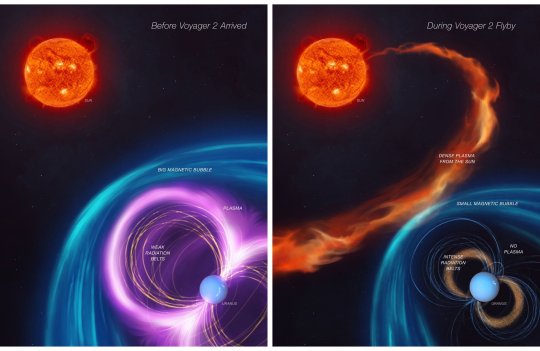
Mining old data from NASA's Voyager 2 solves several Uranus mysteries
When NASA's Voyager 2 spacecraft flew by Uranus in 1986, it provided scientists' first—and, so far, only—close glimpse of this strange, sideways-rotating outer planet. Alongside the discovery of new moons and rings, baffling new mysteries confronted scientists. The energized particles around the planet defied their understanding of how magnetic fields work to trap particle radiation, and Uranus earned a reputation as an outlier in our solar system.
Now, new research analyzing the data collected during that flyby 38 years ago has found that the source of that particular mystery is a cosmic coincidence. It turns out that in the days just before Voyager 2's flyby, the planet had been affected by an unusual kind of space weather that squashed the planet's magnetic field, dramatically compressing Uranus's magnetosphere.
"If Voyager 2 had arrived just a few days earlier, it would have observed a completely different magnetosphere at Uranus," said Jamie Jasinski of NASA's Jet Propulsion Laboratory in Southern California and lead author of the new work published in Nature Astronomy. "The spacecraft saw Uranus in conditions that only occur about 4% of the time."
Magnetospheres serve as protective bubbles around planets (including Earth) with magnetic cores and magnetic fields, shielding them from jets of ionized gas—or plasma—that stream out from the sun in the solar wind. Learning more about how magnetospheres work is important for understanding our own planet, as well as those in seldom-visited corners of our solar system and beyond.
That's why scientists were eager to study Uranus's magnetosphere, and what they saw in the Voyager 2 data in 1986 flummoxed them. Inside the planet's magnetosphere were electron radiation belts with an intensity second only to Jupiter's notoriously brutal radiation belts. But there was apparently no source of energized particles to feed those active belts; in fact, the rest of Uranus's magnetosphere was almost devoid of plasma.
The missing plasma also puzzled scientists because they knew that the five major Uranian moons in the magnetic bubble should have produced water ions, as icy moons around other outer planets do. They concluded that the moons must be inert with no ongoing activity.
Solving the mystery
So why was no plasma observed, and what was happening to beef up the radiation belts? The new data analysis points to the solar wind. When plasma from the sun pounded and compressed the magnetosphere, it likely drove plasma out of the system. The solar wind event also would have briefly intensified the dynamics of the magnetosphere, which would have fed the belts by injecting electrons into them.
The findings could be good news for those five major moons of Uranus: Some of them might be geologically active after all. With an explanation for the temporarily missing plasma, researchers say it's plausible that the moons actually may have been spewing ions into the surrounding bubble all along.
Planetary scientists are focusing on bolstering their knowledge about the mysterious Uranus system, which the National Academies' 2023 Planetary Science and Astrobiology Decadal Survey prioritized as a target for a future NASA mission.
JPL's Linda Spilker was among the Voyager 2 mission scientists glued to the images and other data that flowed in during the Uranus flyby in 1986. She remembers the anticipation and excitement of the event, which changed how scientists thought about the Uranian system.
"The flyby was packed with surprises, and we were searching for an explanation of its unusual behavior. The magnetosphere Voyager 2 measured was only a snapshot in time," said Spilker, who has returned to the iconic mission to lead its science team as project scientist. "This new work explains some of the apparent contradictions, and it will change our view of Uranus once again."
Voyager 2, now in interstellar space, is almost 13 billion miles (21 billion kilometers) from Earth.
TOP IMAGE: NASA’s Voyager 2 captured this image of Uranus while flying by the ice giant in 1986. New research using data from the mission shows a solar wind event took place during the flyby, leading to a mystery about the planet’s magnetosphere that now may be solved. Credit: NASA/JPL-Caltech
LOWER IMAGE: The first panel of this artist’s concept depicts how Uranus’s magnetosphere — its protective bubble — was behaving before the flyby of NASA’s Voyager 2. The second panel shows an unusual kind of solar weather was happening during the 1986 flyby, giving scientists a skewed view of the magnetosphere. Credit: NASA/JPL-Caltech
7 notes
·
View notes
Text
March 5 (UPI) -- Engineers at NASA's Jet Propulsion Laboratory have conserved energy supplies on the record-setting Voyager 1 & 2 deep space probes nearly 50 years after their missions launched to extend them further.
NASA launched the probes in 1977, which rely on a diminishing radioisotope power system that uses the heat from decaying plutonium to generate electrical power.
Each probe loses about 4 watts of power every year, but NASA has extended their respective missions by shutting down some of its instruments to conserve their remaining power sources.
"The Voyagers have been deep space rock stars since launch," Voyager project manager Suzanne Dodd said. "We want to keep it that way as long as possible."
Dodd said the probes' electrical power is running low and only would have a few more months of power before shutting down and ending their missions without taking steps to reduce power consumption.
Each spacecraft contains identical sets of 10 scientific instruments, some of which are designed to collect data during planetary flybys.
The instruments for the flybys have been turned off after each probe completed exploratory missions of the solar system's gas giants.
Other instruments have remained under power while studying the solar system's heliosphere, which NASA describes as a "bubble of solar wind and magnetic fields created by the Sun."
The remaining powered instruments also will help the probes explore interstellar space, which is the region located outside the heliosphere.
The Voyager 1 and Voyager 2 probes reached the edge of the heliosphere and began entering interstellar space in 2012 and 2018, respectively.
They are the only man-made spacecraft that have operated in interstellar space.
NASA engineers in October shut down an instrument that measures the amount and direction of electronically charged atoms called plasma on Voyager 2.
Engineers shut down the same instrument on Voyager 1 years ago due to degraded performance.
Mission engineers last week shut down the cosmic ray subsystem on Voyager 1, which was used to study cosmic rays, including protons, by measuring their energy and flux.
The cosmic ray subsystem used three telescopes to accomplish its mission and determine when and where the probe exited the heliosphere.
Mission engineers also are preparing to deactivate Voyager 2's low-energy charged-particle instrument that measures ions, electrons and cosmic rays that originate from within the solar system and galaxy.
"The Voyager spacecraft have far surpassed their original mission to study the outer planets," NASA Voyager program scientist Patrick Koehn said.
"Every bit of additional data we have gathered since then is not only valuable bonus science for heliophysics, but also a testament to the exemplary engineering that has gone into the Voyagers - starting nearly 50 years ago and continuing to this day."
The NASA engineers say the probes should operate for another year before each will require another system to be shut down to preserve more power and extend their missions.
The power-conservation plan for the Voyager 1 and 2 probes should enable them to remain active into the 2030s.
Each probe has suffered deep-space weathering for 47 years, which might lessen their service lives.
Each probe is the most distance man-made object ever built with Voyager 1 traveling more than 15 billion miles from Earth and Voyager 2 more than 13 billion miles, according to NASA.
"Every minute of every day, the Voyagers explore a region where no spacecraft has gone before," Voyager project scientists Linda Spilker said.
3 notes
·
View notes
Text
Logos and Pathos (Book 3) Chapter Four
Spock x Empath! Reader
Chapter Four: Missing Brain
Summary: The Enterprise is attacked and takes a very strange item from one crew member.
Captain’s Log: During the Enterprise’s travels, we’ve encountered a strange ship. We are on Red Alert, unsure if it is friend or foe as it refuses to answer any of our transmissions.
“Phaser banks standing by, sir,” reported Sulu. “Range 43,000 and closing.”
“What do you read, Mr. Spock?” asked Kirk.
“Configuration unidentified,” said Spock. “Ion propulsion, high velocity, though of unique configuration.”
“(L/N)?” asked Kirk.
“No contact, sir,” reported (Y/N). “Hailing on all frequencies and languages but no response. Now using standard interstellar symbols.”
“Keep trying,” said Kirk. “Magnification ten, Mr. Chekov.”
“Aye, sir,” said Chekov.
“13,000 and closing,” warned Sulu.
“Well, Scotty?” asked Kirk.
“It beats me, but isn’t she a beauty?” remarked Scotty, gazing at the ship with admiration.
“Interesting design,” said Kirk.
“I’ve never seen anything like her, and ion propulsion at that! Ah, they could teach us a thing or two,” said Scotty.
“Life-forms, Mr. Spock?” asked Kirk.
“One: humanoid or similar,” said Spock. “Low level of activity. Life support systems functioning. Interior atmosphere: conventional nitrogen-oxygen. Instruments indicate a transferal beam emanating from the area of the humanoid life-form.”
“Directed at what?” asked Kirk, on guard.
“Directed at the guard of the Enterprise, Captain,” said Spock, eyes hardening warily.
“Security guard,” called Kirk. “Security guard to the Bridge.” He froze as a beam appeared on the Bridge, and a woman materialized.
The Bridge crew stared at her in lilac and pink heels and a dress. She smiled as her eyes landed on Spock, who raised an eyebrow.
(Y/N) cocked their head as very calm, pleasant emotions emanated from the woman. However, the emotions were…simple, like there wasn’t much going through her mind.
“I’m Captain James Kirk,” said Kirk. “This is the Starship Enterprise.”
The security guard rushed in, phasers drawn, but the woman calmly lifts a device on her wrist and a low tone hummed. Instantly, (Y/N) felt a force inside their head, and they seized up. Around them, their fellow crew members froze before collapsing unconscious. The last thought (Y/N) had as they collapsed was how Spock stumbled and reached out for them.
Spock…
l
(Y/N) jerked awake, and while Kirk turned to monitor the Enterprise, but their first thought was Spock. He was gone from his post.
“Spock!” breathed (Y/N), and their stomach dropped. Something was very wrong.
“(L/N)? Do you know where Spock went?” asked Kirk worriedly.
(Y/N) shook their head. “He was gone when I woke up.”
“Jim! (Y/N)!” Bones’s urgent voice came over the intercom. “You’d better come down to Sickbay right now.”
(Y/N) was out the door before Kirk could even answer Bones.
l
(Y/N) flew through Sickbay doors with Scotty and Kirk behind them. Their eyes widened as they saw what Bones had been so worried about.
Spock lay underneath life-support systems, and a gold cloth was wrapped around his head. (Y/N) was by his side in an instant, holding his hand worriedly. They couldn’t feel his emotions, which was normal, but he felt…emptier.
“I found him on the table,” said Bones.
“Like this…?” asked (Y/N).
“No, not like this,” said Bones.
“What happened?” (Y/N)’s golden eyes were filled with concern as they looked at Bones.
“I don’t know,” said Bones.
“Why is he on complete life support?” asked (Y/N), holding Spock’s hand tighter. “Was he…?”
“He was worse than that,” said Bones.
“What does that mean?” questioned (Y/N).
“(Y/N)…” Bones had a soft spot for the Celian, they were like a little sibling to him, and he was hesitant to tell them that something had happened to Spock.
“Bones, I can tell it’s bad,” said (Y/N), watching Bones’s fear and worry swirl around him.
“…His brain is gone,” said Bones. “It’s been removed surgically.”
(Y/N) looked down at Spock as their heart ached. His brain? Spock’s brain? The very thing that made him Spock? “How…how could he survive?” If he was alive, there was hope.
“It’s the greatest technical job I’ve ever seen. Every nerve ending of the brain must’ve been neatly sealed. Nothing ripped, nothing torn, no bleeding,” said Bones. “It’s a medical miracle.”
“But if he’s missing his brain…he’s dying,” said (Y/N).
“No. That incredible Vulcan physique hung on till life support took over,” said Bones. “His body lives.” He looked at (Y/N). “We’ve still got him, don’t worry. The autonomic functions continue…but there is no mind.”
(Y/N) could feel the sympathy of all their friends, but they could only focus on Spock. They had to bring him back. They had to. They couldn’t leave him like this.
“That woman…” said Kirk.
“Aye,” said Scotty.
“What woman?” asked Bones.
“From the ship,” said (Y/N). “She beamed aboard and used a device to send us unconscious.”
“She took it,” said Kirk decisively. “I don’t know why, or where, but she must have taken it.” He looked at Bones. “Bones, how long can you keep him functioning?”
“I can’t give you any guarantee,” said Bones.
“Please, Bones,” said (Y/N).
“If it happened to a human, I’d say indefinitely, but Vulcan physiology mixing with human limits what I can do,” said Bones. “Spock’s body is much more reliant upon that tremendous brain for life support.”
“Then we’ll have to take him with us,” decided Kirk.
“Take him?” asked (Y/N) in confusion.
“Take him where?” questioned Bones.
“In search of his brain, Doctor,” said Kirk. “From what you say, the moment we find it, we must restore it to his body, or…we lose him.” He looked at (Y/N) in sympathy.
(Y/N) steeled themself. They had to do something. They refused to just leave Spock like this. They wouldn’t give up on the man they loved.
“Jim…where are you going to look in this whole galaxy?” asked Bones. “Where are you going to look for Spock’s brain? How are you going to find it?”
“We’ll find it,” said (Y/N), and all eyes turned on them. “We’ll find it.”
“Even if you do, I can’t restore it,” said Bones. “I don’t have the medical technique.” He was harsh, but it was his own way of showing worry that swept over (Y/N).
“If it was taken out, it can be put back in,” said (Y/N). “That’s logic.”
“But I don’t know how!” Bones’s words were angry, but his emotions read of guilt and frustration. He wasn’t sure how to help Spock, and for all their arguments, he liked the Vulcan and was his friend. He didn’t want to lose him.
“Whoever took it has the knowledge. We’ll get her to tell us,” said (Y/N) in determination.
“We need to find it in twenty-four hours,” said Bones.
(Y/N)’s hand curled into a fist of determination. Kirk put a hand on their shoulder and faced Bones. “You and Scotty have Spock ready. We’ll find out where that woman went.”
(Y/N) nodded. “We’ll find him.” We’re coming, Spock.
l
“I’ve got it again, sir—an ion trail,” said Sulu. He had been working hard to get a track on the ship that had taken Spock. “It’s from that ship of hers alright.”
(Y/N) smiled. “Thank you, Sulu.”
“Where does it lead, Mr. Chekov?” asked Kirk.
“System Sigma Draconis,” said Chekov.
“Lock on, Mr. Sulu,” said Kirk. “Maximum speed.” He looked at (Y/N). “We’re going to get him back, (L/N).”
“Of course we are,” said (Y/N). “I won’t leave him like this.”
Kirk looked at them and nodded. (Y/N) loved Spock, and Kirk had seen many times how far (Y/N) went for the people they cared about. If anyone would make sure Spock was saved, it would be (Y/N).
l
Fifteen anxiety-inducing hours had passed. Nine hours remained to save Spock. (Y/N) and everyone on the Bridge’s emotions had been a swirl of concern as they single-mindedly focused on staying on the tail of the ship that had taken him.
(Y/N) wanted to dive into the work, too, but Uhura was quick to make sure they rested since she knew (Y/N) would drive themself into the ground before even getting to Spock if given the chance.
“Captain, I’ve lost the trail!” said Sulu.
(Y/N) tensed, and Kirk jumped up. “All scanners, extreme sweep.”
(Y/N) moved to their station, but Uhura batted their hands away. “Rest, (Y/N). You’ll need your energy when you find Spock.”
“Well?” asked Kirk.
“Nothing, sir, nothing at all,” said Sulu.
“It’s gone, sir, a sudden deaction shift,” said Uhura.
“We’ve lost her trail, but she went into that system,” said Sulu.
“Mr. Chekov, put a schematic of Sigma Draconis on the screen,” ordered Kirk.
“Aye, Captain,” said Chekov. A diagram appeared.
“Redout, Mr. Chekov,” said Kirk.
“Sun: spectral type, Gamma IX. Nine planets, three of them Class M, possessing sapient life according to reports and long-range scanning,” said Chekov.
“She was breathing our air,” said (Y/N). “So a Class-M planet has to be her home.”
Kirk nodded. “Show us the M-Class planets, Mr. Chekov.”
“The one on the left, number three, rates Letter B on the industrial scale. Earth equivalent approximately…1485,” said Chekov. “Second planet, Class-M, number four, rates Letter G. The year 2030.”
“But that ship, Captain, either it was many years ahead of us, or it was the most incredible design fluke in history,” said Sulu.
“Third Class-M planet, Mr. Chekov?” asked Kirk.
“Number six, no sign of industrial development,” said Chekov. “At last report, in a glacial age. Sapient life plentiful, but on a most primitive level.”
Kirk considered. “Now, as I understand you, Mr. Chekov, there are three M-Class planets. Not one of which is capable of launching an interstellar flight.”
“No, sir,” said Chekov.
“And yet one of them accomplished it?” said Kirk.
“Yes, sir,” said Chekov.
“Thank you, Mr. Chekov,” sighed Kirk.
“Captain, I’m picking up high energy generation on planet six,” said Uhura.
“That’s the primitive glacial planet,” said Kirk in confusion.
“Uhura, what’s the source?” asked (Y/N).
“It could be natural: volcanic activity, steam, any number of causes, but it’s very regular,” said Uhura.
“What do your surface readings show, Mr. Chekov?” asked Kirk.
“No sign of organized civilization,” said Chekov. “Primitive humanoids picked up at irregular intervals.”
“With regular pulsations of generated energy?” questioned Kirk.
(Y/N) furrowed their brow. That didn’t make sense; it was a paradox.
“I can’t explain, sir,” said Chekov.
“I cannot afford to guess wrong,” said Kirk. “We’ve got to choose the right planet, get there, find Spock’s brain in…eight hours and thirty-five minutes. Recommendations, Mr. Chekov?”
“Sigma Draconis III,” said Chekov. “It’s closest. Heaviest population.”
“But a technological rating of only three,” said Sulu. “They couldn’t possibly have put that ship we saw into space.”
“We’ve seen stranger things,” remarked (Y/N).
“I’d still say planet four,” said Sulu. “At least planet four is ahead of three technologically.”
“But advanced ion propulsion is beyond even our capabilities,” said Kirk. “It’d be a miracle if they had developed it.”
“But what does anyone want with Spock’s brain?” said (Y/N), shifting uncomfortably.
“Yes, why would they want it?” wondered Kirk. “Eight hours and thirty-four minutes.” Time was ticking away. “Planet six is glaciated, you say?”
“Several thousand years at least,” confirmed Chekov. “Only the tropical zone is ice-free.”
“But the energy…regular,” murmured (Y/N). “That’s there and real.”
“Yes,” said Uhura. “It doesn’t make sense, but it’s there.”
“Have the Transporter Room stand by,” decided Kirk. “I’m taking a landing party down to planet six.”
“Aye, aye, sir,” said Uhura, getting up. She squeezed (Y/N)’s shoulder reassuringly before alerting the Transporter Room.
“A hunch, Captain?” asked Sulu.
“A hunch, Mr. Sulu,” said Kirk.
“…And if we guess wrong, Spock is dead,” said (Y/N), furrowing their brow and swallowing hard. “So we can’t be wrong.”
l
Scotty, Chekov, Kirk, (Y/N), and two security officers arrived on Sigma Draconis VI. The primitive glaciated planet loomed with mountains over them. Eight hours and twenty-nine minutes remained.
“Life form readings, Mr. Spock—Uh, Mr. Scott.” Kirk had to correct himself due to the strange disappearance of his First Officer.
“Scattered,” said Scotty. “Widely spaced. Humanoid all right. On the large side.”
“We better watch out,” said Kirk. “We know they aren’t as developed yet.”
“Aye,” said Scotty.
“Readout, Mr. Chekov,” said Kirk.
“No structures, Captain,” said Chekov. “No mechanized objects that I can read. No surface consumption, no generation of energy. Atmosphere is perfectly alright, of course. Temperature, a high maximum of forty. Livable.”
“Captain,” said (Y/N). “I can feel erratic emotions. Out in the rocks. There are a couple of people approaching.”
“Phasers on stun,” commanded Kirk. “I want them conscious.”
Carefully, the landing party approached where (Y/N) sensed emotions, and Scotty scanned for precise locations. A moment later, men with scraggly bears wearing pelts through rocks and sticks at the group. The Starfleet officers scattered behind rocks as they were bombarded. Kirk reached up and stunned one. The rest of the humanoid group stared at their fallen friend. Fear shot through them, and they ran for their own lives, thinking their friend dead.
Kirk, Scotty, and (Y/N) approached the fallen man as he groaned. Fear spiked in him, and it prickled (Y/N)’s skin.
“We mean you no harm,” they assured him. They touched his arm for a moment and let their calm emotions flood him with the knowledge they had no ill intentions. “We’re not your enemies. We just want to talk.”
“You are not the others?” murmured the man.
“No. We come from another place,” said (Y/N).
“You are smaller…like the others,” said the man warily.
“Who are the others?” asked Kirk.
“The givers of pain…and delight,” said the man.
“Do they live here with you?” said (Y/N).
“No. They come. They give pain and delight.”
“Do they come from the sky like us?” asked Kirk.
“They are here. You will see,” said the man. “The others will come for you. They come from all like you and me.”
They come for men? wondered (Y/N), exchanging a worried look with Kirk. “Do they come for your women as well?”
“Women?” repeated the man in confusion as if the word held no meaning.
“The typical female of your kind,” said Kirk in a brief explanation.
“Your words…say nothing.”
“Don’t you and your kind have mates or partner?” asked Kirk. The man stared in confusion, and Kirk pursed his lips.
“Can you take us to find the others?” (Y/N) needed to see if these people had taken Spock. This was proving to be a suspicious planet, and with their luck, Spock would be at the middle of a planet-wide issue.
“No one wants to find them!” said the man, panicking slightly.
“We do,” said (Y/N), trying to calm him again but remaining firm.
“Take us there, and we’ll let you go,” said Kirk.
“Captain!” alerted Chekov. “Five hundred meters in that direction, there’s a foundation under the surface. A huge one! Registrations all over the place.”
“Buildings?” asked Kirk.
“Yes, sir. Immensely old, completely buried, but they were here once,” said Chekov.
“That could imply some technological advancements hidden from the surface,” said (Y/N). That could be a clue to Spock.
“Somewhere down there is where the others live,” said the man.
(Y/N) and Kirk exchanged a look. That was where they had to go.
“Scotty, see if you can find a way down,” said Kirk hurriedly.
“Aye, sir!” said Scotty.
“No! No!” The man got up and panicked. Kirk tried to grab him, but the man was quite strong. “No! Do not go there!” He pushed Kirk back and ran.
“It’s alright,” said Kirk as a security officer tried to run after the man. “Let him go.”
“What could the others do to cause such terror?” asked Chekov.
“What was it he said, pain and delight?” remarked Kirk.
“Peculiar mixture,” said Chekov.
“A dead and buried city on a planet in the glacial age,” reviewed (Y/N). “The male humanoid doesn’t know what a female is and neither what it means to have a partner.” They frowned. How were there adults?
“Captain! (L/N)!” called Scotty. “Over here, sir!”
Chekov, (Y/N), and Kirk ran over to a cave opening Scotty had found.
“There’s food in there,” said Scotty. “And a whole pile of other stuff.”
“A storehouse for the men?” offered Chekov.
“I don’t think so,” said Kirk. He pointed to the stack of tools and light in the corner. “Metal. Forged. Tempered. Our apish friends didn’t make these.”
“What do you think?” said (Y/N), looking at Scotty.
“It could be a warning device to keep the men away from the food,” said Scotty.
“Or the food could be a lure, set by the ‘others’ to bring the men in here,” said (Y/N). “In that case, the beam would be a signal.”
“And this cave, a trap,” said Kirk.
“If it will trap the men for the others, Captain, won’t it trap us, too?” said Chekov.
“Good point,” said (Y/N), leading the way out.
“Kirk to Enterprise,” radioed Kirk once they were out.
“Enterprise, Uhura here,” said Uhura.
“Have Dr. McCoy beam down immediately,” said Kirk.
“Aye, aye, sir,” said Uhura.
“Mr. Chekov, you and the security team will remain here at the entrance,” said Kirk. “We’ll be in constant contact with you.”
“Aye, sir,” said Chekov.
The golden glow of the Transporter appeared, and Bones and another figure formed on the planet. (Y/N)’s eyes widened.
Spock’s body stood straight with a device in his head.
Taglist:
@a-ofzest
@grippleback-galaxy
@genderfluid-anime-goth
@groovy-lady
@im-making-an-effort
@unending-screaming
@h-l-vlovesvintage
@neenieweenie
@keylimeconstellation
@wormwig
@technikerin23
@ilyatan
#logos and pathos#x reader#x gn reader#gn reader#x nb reader#nb reader#empath reader#empath!reader#empath#commander spock#star trek spock#spock#mr spock#spock x reader#tos spock#spock tos#st tos#star trek the original series#star trek x reader#star trek fanfic#star trek tos#star trek#leonard mccoy#bones mccoy#dr mccoy#james t kirk#james kirk#jim kirk#kirk#captain kirk
37 notes
·
View notes
